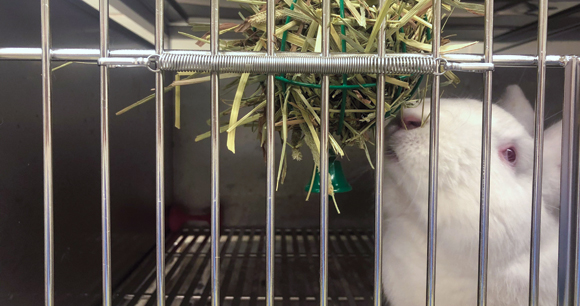Enrichment Strategies for Rabbits in Research
One of the goals of environmental enrichment is to encourage species-typical behaviors while discouraging abnormal behaviors. Assessing the effectiveness of various enrichment strategies can be a challenging endeavor, particularly for prey species who may exhibit freezing responses in the presence of people. The goal of our study, which was funded by an AWI Refinement Grant, was to determine if we could use various environmental enrichment strategies to promote species-specific behaviors, decrease potentially abnormal behaviors, and improve the overall welfare of rabbits in laboratories.

We began by looking at cage size as a form of enrichment. We video recorded rabbits in three cages that varied in size: a standard housing cage (25 x 29.5 x 16 inches), a medium-sized cage (28 x 45 x 27 inches), and a large run (65 x 70 x 96 inches). After reviewing the videos, we constructed an ethogram of laboratory rabbit behaviors. We then used that ethogram to quantify behaviors seen in the rabbits in the various cage sizes.
We found that rabbits housed in large runs spent an average of 71.8 percent of the time performing active, exploratory behaviors, 24.2 percent resting, and only 4 percent of time performing self-directed grooming behaviors. By comparison, rabbits housed in the standard cages spent 30.7 percent of the time engaged in active behaviors, 34.8 percent resting, and 34.5 percent grooming. The differences in time spent performing active behaviors and time spent performing self-directed grooming behaviors were statistically significant (p<0.05). This led us to surmise that housing rabbits in larger cages has a positive impact on their welfare, allowing them more space and opportunity to perform active, species-typical behaviors while reducing potentially stereotypic self-directed grooming behavior.
In facilities where rabbits aren’t currently housed in large runs, the standard cage may nonetheless be much improved by adding relevant items into the cage. Therefore, we decided to explore if the provision of enrichment devices while being housed in the standard size cage could promote the increased expression of active behaviors similar to what was seen with rabbits in the large runs. We selected three devices: a hanging toy, a destructible device, and a dig bin. The provision of all three enrichment devices led to more time spent performing active, exploratory behaviors (64.9, 77.1, and 70.0 percent of time, respectively) than what was seen in control rabbits with no enrichment device (37.6 percent of time). The enrichment devices also reduced the time spent performing grooming behavior (hanging toy 3.3 percent, destructible 2.6 percent, and dig bin 6.7 percent of time) compared to control rabbits with no enrichment device (24.4 percent of time). These changes were again statistically significant (p<0.05).
Overall, the provision of large runs or the addition of enrichment devices into standard cages encouraged a broad spectrum of active, species-typical rabbit behaviors, while simultaneously reducing potentially stereotypic self-directed grooming behavior. We have since added these enrichment devices to our care and use program and find them to be an easy, cost-effective way to improve welfare.
This study was funded by the AWI Refinement Research Award program. Learn more about this program or view additional studies.
Program Terms: Animals in Laboratories
AWI Quarterly Terms: Feature Article
Related News
New Analysis: Animal Welfare Act Enforcement Deteriorates Following SCOTUS Ruling
In Program: Animals in LaboratoriesThe US Department of Agriculture, long known for its lackluster enforcement of the Animal Welfare Act (AWA), appears in recent years to have drifted even...
AWI Statement on Trump Administration’s Plan to Reduce Animal Experimentation Amid Attack on Science
In Program: Animals in LaboratoriesThe Animal Welfare Institute (AWI) applauds recent announcements by the National Institutes of Health and the US Food and Drug Administration about their plans to reduce the use of...
AWI Scholarship Winners Campaign for a Better World for Animals
In Program: Animals in Laboratories, Farmed AnimalsThe Animal Welfare Institute (AWI) announced today the 12 winners of a scholarship designed to invest in future leaders who seek to improve the lives...
AWI Supports Phasing Out Animal Use in Research and Testing, but Proper Planning is Essential to Protect Animals and Science
In Program: Animals in LaboratoriesLast month, both the National Institutes of Health and the US Food and Drug Administration announced plans to phase out the use of animals in...